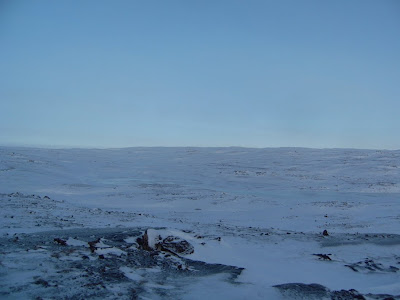On Monday we had a bit of a storm and my cab driver told me that it was almost -60 degrees C with the wind chill… -60! I was home on Monday and Tuesday with a sore throat and cough, so I was really getting anxious to get out of the house. Now that I’m back to work though, I feel like going home and crawling back into bed, lol. It’s amazing how quickly work can pile up.
Last Saturday was a beautiful, sunny day so I decided to get outside for some fresh air. I bundled up to what I thought was a sufficient degree and headed out (don’t worry, I didn’t venture far from town). It was so cold that my usually quite flexible backpack was frozen stiff after ten minutes and my freshly charged camera died after two minutes. It was so cold that the moisture in my breath froze in my nostrils before it even fully escaped my body and I got icicles up my nose. It was so cold that the thermometer on my backpack, which goes down to -30 degrees C, was only registering a little drop of red in the little ball at the bottom. At that temperature metal burns your skin instantly as if you just touched a hot stove and the skin on your face feels stiff. I took a couple of pictures from my favourite lookout before my camera died and then hurried home to thaw.
It is amazing to me that the houses stand up to this type of cold so well. I met someone the other day that was visiting Iqaluit (and the North) for the first time and he commented that most of the houses look like “normal” houses down south (don’t be confused… “down south” up here means where you live, not the Caribbean). After hearing him I recalled thinking something similar when I first landed in Iqaluit. This got me thinking… what did we expect to find? I certainly didn’t think that people would be living in Igloos, but I can’t quite define what I expected to see. I guess when you come here to such a remote and hostile environment you don’t expect to find a town that looks very much like most small towns in the south. This, of course, excludes the ice cube shaped schools, and igloo domed church, but most buildings are pretty standard.
Frobisher Bay is finally frozen over, and the skidooers have been quick to get out on the ice. They claim that on a snow machine you can go out on an inch of ice, as long as you are going fast enough, though I know I’m not tempted to test that theory. A father and son went through the ice a couple of weeks ago; luckily they both survived, but I can’t imagine that it was a very pleasant experience.
I have been keeping myself busy reading, working on a cross-stitch, and starting a quilt! I know, all sounds very domestic, but these days I am quite confined to my domicile. In a couple of months when the weather warms and that’s when everyone gets out with their cross-country skis, snow shoes, sleds and what not. There is a big spring festival in April that I am really looking forward to. There are skidoo and dog sled races, igloo building contests, kite-surfing (on snow and ice), craft shows… you name it. The festival lasts for ten days.
 These are sundogs... a sundog is an atmospheric phenomenon that creates bright spots of light in the sky, often on a luminous ring or halo on either side of the sun. Sundogs are made during very cold weather by ice crystals called diamond dust drifting in the air at low levels. These crystals act as prisms, bending the light rays passing through them with a minimum deflection of 22°. If the crystals are randomly oriented, a complete ring around the sun is seen — a halo. But often, as the crystals sink through the air they become vertically aligned, so sunlight is refracted horizontally on either side of the sun.
These are sundogs... a sundog is an atmospheric phenomenon that creates bright spots of light in the sky, often on a luminous ring or halo on either side of the sun. Sundogs are made during very cold weather by ice crystals called diamond dust drifting in the air at low levels. These crystals act as prisms, bending the light rays passing through them with a minimum deflection of 22°. If the crystals are randomly oriented, a complete ring around the sun is seen — a halo. But often, as the crystals sink through the air they become vertically aligned, so sunlight is refracted horizontally on either side of the sun. Frobisher Bay... it's finally frozen!
Frobisher Bay... it's finally frozen! Yeah, that's right... not even registering.
Yeah, that's right... not even registering.


